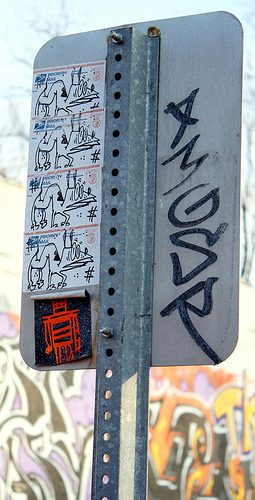 Graffiti is often associated with old crumbling buildings and urban decay, but I think it is just the opposite of that. Graffiti serves a much greater political, cultural, and creative purpose that can only be noticed once we stop to actually observe what’s around us. As human beings we filter the majority of sensory information we receive from our environment. It’s just not possible to process everything, but if you start making the effort to look for graffiti, you will see it everywhere and start to understand its importance.
Graffiti is often associated with old crumbling buildings and urban decay, but I think it is just the opposite of that. Graffiti serves a much greater political, cultural, and creative purpose that can only be noticed once we stop to actually observe what’s around us. As human beings we filter the majority of sensory information we receive from our environment. It’s just not possible to process everything, but if you start making the effort to look for graffiti, you will see it everywhere and start to understand its importance.
If we accept graffiti as art, and not vandalism, the possibilities it holds for St. Louis are endless. One thing that makes St. Louis truly unique is the legal graffiti exposition on the floodwall in downtown St. Louis. Colorful murals and tags cover the two-mile stretch of wall along the river. The graffiti wall was originally part of an event called Paint Louis, which celebrated street art by inviting artists to St. Louis to spray-paint murals. The graffiti wall really is a beautiful attraction worth visiting, and one that St. Louis should maintain and promote. Only a handful of cities across the country have designated legal graffiti walls.
The floodwall is not the only section of St. Louis that is host to street art. One of the most eclectic shopping streets in America, the Delmar Loop has a wide variety of murals, stickers, and tags–tags are a graffiti writer’s unique pen name. The Loop attracts many graffiti artists from the St. Louis area, but on Delmar, stickers are the most prevalent form of street art. What’s great about the graffiti on the Loop is that it’s always changing, and there are new stickers up every week. Websites, artists, and local shops on the Loop use stickers as an inexpensive but creative marketing tool to promote their businesses.
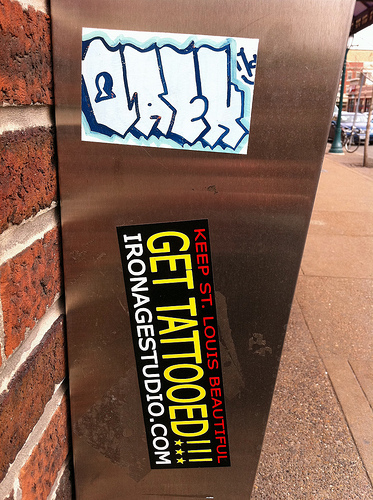
These artists come back multiple times to add new street art. Each graffiti writer has a unique tag name or symbol that makes his or her work recognizable. Once familiar with an artist’s work, you can slowly pick up on where different graffiti writers have visited, and what neighborhoods they frequent just by keeping an eye out.
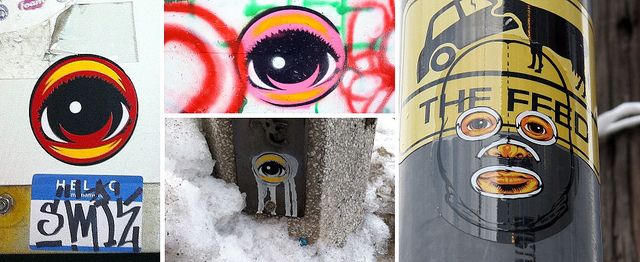
But most importantly, these people are claiming a part of their city with their name and establishing a voice for an underground scene. These artists show support for the continuance of graffiti in St. Louis, and pride for the city itself by frequenting certain neighborhoods and continuing to post their work.
Graffiti serves a variety of purposes in a community, based on the artist’s intentions and the audience’s perception. Street art can be used for self or business promotion, to send a political message, or simply as humor or entertainment.
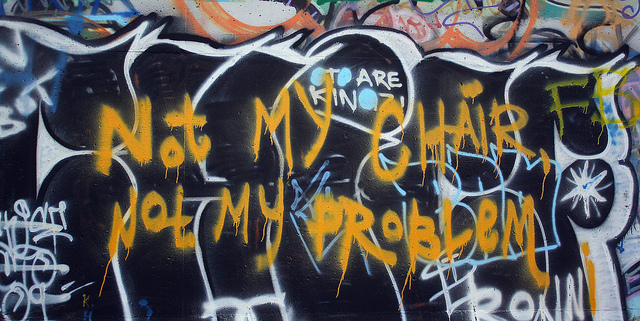
Graffiti, in itself, is charged with political meaning. By law, it is illegal. Graffiti therefore is a rebellious act, carried out deliberately. Graffiti is not placed by chance or accident. Location and visibility are important in placing a sticker, tag, or mural. Graffiti is often placed strategically to interact with its environment, and can be meaningless if it is taken outside of its intended context.
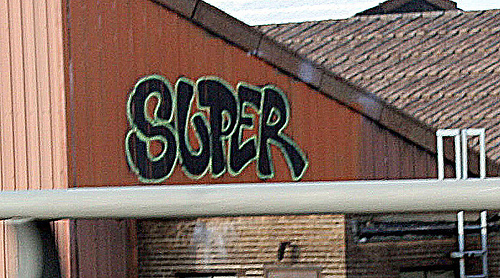 What really goes unnoticed is the talent and dedication of street artists. A lot of graffiti is simply really impressive or creative art. Multi-layered stencils and large murals take large amounts of planning and practice. These artists are also inventive in terms of placement. It takes zeal to reach the obscure, dangerous, and abandoned locations where graffiti is often placed. Driving on I-64 near midtown, there are old buildings with large tags on their roofs that are visible from the highway going both East and West.
What really goes unnoticed is the talent and dedication of street artists. A lot of graffiti is simply really impressive or creative art. Multi-layered stencils and large murals take large amounts of planning and practice. These artists are also inventive in terms of placement. It takes zeal to reach the obscure, dangerous, and abandoned locations where graffiti is often placed. Driving on I-64 near midtown, there are old buildings with large tags on their roofs that are visible from the highway going both East and West.
Next time you see graffiti on a sixteen-foot tall pedestrian light, or the top of a building, consider how the graffiti artist managed to climb to that spot, and place their work without messing up or being caught.
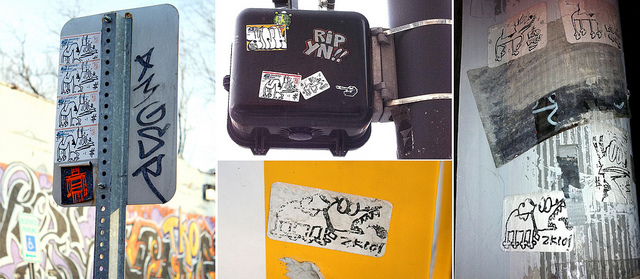
Street art is unique because it’s the only art form that is accessible to everyone, but at the same time it’s always changing. I’ve found it important to photograph graffiti because it is so transient. A piece of graffiti may at any point be covered by other graffiti or taken down, so taking a picture is the only way to guarantee the image lasts. At the same time, that is the beauty of graffiti. It is not official. It isn’t on display at a museum. It’s there until someone chooses to cover or remove it, and that’s the unpredictability of it. Graffiti is the only form of art that is truly open to and for everyone. You don’t buy a ticket for admission to see graffiti; it’s just there in the open, placed for anyone and everyone to see. It’s free, and some choose to ignore it, but I think it’s worth looking out for.
Cities such as New York and Berlin are famous for their ever-growing and changing graffiti movements. Although St. Louis is not on the same level as a hub of graffiti, events like Paint Louis and promotion of local graffiti artists can do a lot to benefit the culture and diversity of the city.
 Graffiti is often associated with old crumbling buildings and urban decay, but I think it is just the opposite of that. Graffiti serves a much greater political, cultural, and creative purpose that can only be noticed once we stop to actually observe what’s around us. As human beings we filter the majority of sensory information we receive from our environment. It’s just not possible to process everything, but if you start making the effort to look for graffiti, you will see it everywhere and start to understand its importance.
Graffiti is often associated with old crumbling buildings and urban decay, but I think it is just the opposite of that. Graffiti serves a much greater political, cultural, and creative purpose that can only be noticed once we stop to actually observe what’s around us. As human beings we filter the majority of sensory information we receive from our environment. It’s just not possible to process everything, but if you start making the effort to look for graffiti, you will see it everywhere and start to understand its importance.
